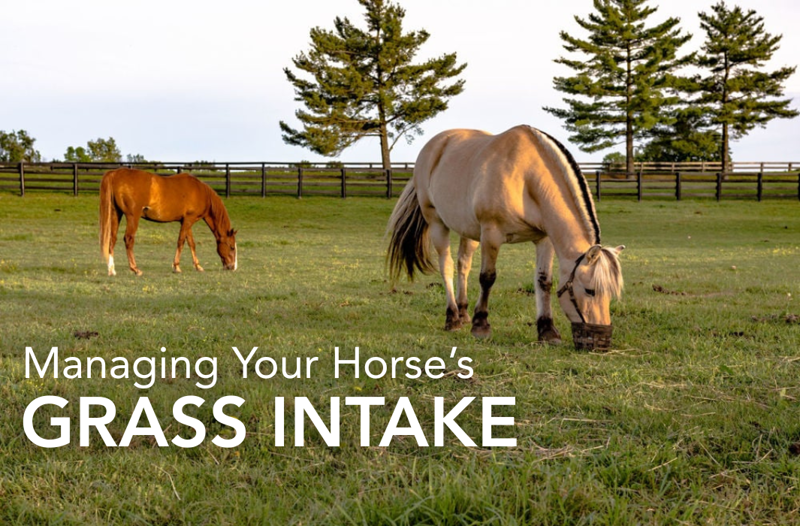As you might expect, the amount of time our horses spend in the field varies with the seasons, with more horses living out in summer as the days get longer and the weather and ground conditions improve, and more horses being completely stabled in winter primarily to avoid fields becoming poached. Regardless of the time of year, most owners report giving their horses daily access to pasture, even if only for a few hours.
Why turnout is important for horses
Time in the field allows horses to move freely, interact with their surroundings, interact with other horses visually if in separate fields, and physically if they can touch, and to perform grazing behaviour that is so important to them for maintaining mental and physical health. Time in the field also supplies nutrients and should be accounted for when developing and managing your horse’s diet. Accounting for the energy (calories), protein, fatty acids, vitamins, and minterals horses obtain from grass is not always the primary consideration by owners, as it is easy to view the field as a place where horses exercise and enjoy time being a horse, and not as a self-service buffet. Not accounting for grass as a source of nutrients and energy can lead to horses consuming an unbalanced diet that affects their condition, health and performance.
Energy and nutrient content of grass
Accounting for the grass our horses consume is not straight forward. Energy and nutrient content change with grass stage of growth, and determining how much your horse eats when in the field is particularly challenging. The only real way of knowing the nutrient content of the specific grass your horse is eating is to analyse for its nutrient content. Commercial premises producing high value horses are more likely to undertake grass nutrient analysis, although analysis of grazing for horses is still not common practice. One potential reason for limited testing of grass is that the results gained are specific to the sample taken at a certain point in time, so may not be applicable to all parts of your pasture or to grass at a different growth stage. Despite these limitations, testing for nutrient content is advised as it is better than not having any information on the grass your horse is eating.
Determining how much grass your horse eats when turned out is the other challenge making it difficult to account for grass intake in your horse’s diet. In the research setting, measuring the amount of grass before horses graze and then again after grazing, enables estimates of how much grass is consumed. This method is relatively straight forward but is only an estimate due to sampling small sections of grass, meaning variations in grass cover are not accounted for. This method also does not account for the selective grazing behaviour of horses who will eat certain plant species and completely ignore others. It is also only suitable for estimating intake over a short period of time (hours) as it does not account for grass growth over the grazing period.
A more accurate estimate of grass intake can be gained from information on the digestibility (amount of nutrients absorbed by the animal) of the grass consumed and the amount of faeces produced. Markers are used to gain such information, and are substances that are indigestible to the horse, meaning they can be tested for in the faeces.The use of markers is generally more accurate than measuring grass before and after grazing, however it is only suitable for use in the research setting due to the requirement for chemical markers and laboratory equipment.
Due to the difficulties in determining our horses’ grass intake, and the potential for grass to trigger laminitis in some equids, we need practical methods to account for energy and nutrients gained from grass. We also need practical methods to manage grass intake, whether this is limiting the amount of grass consumed for those animals prone to laminitis, insulin dysregulation and weight gain, or optimising grass intake for growing animals and those needing to gain weight. For healthy horses, the easiest way of accounting for grass intake in the diet is to monitor their weight and fat stores. Monitoring body weight and fat stores by regularly weigh taping and fat scoring your horses is straight forward, quick and non-invasive, and indicates if more or less energy is required (Figure 1). If all other parts of your horse’s diet, exercise and management remain the same and they are gaining weight then they must be gaining more energy from the grass, and vice versa if they are losing weight. You can then review your horse’s diet to identify what changes are needed to enable them continued access to the field whilst keeping them at a healthy body weight.
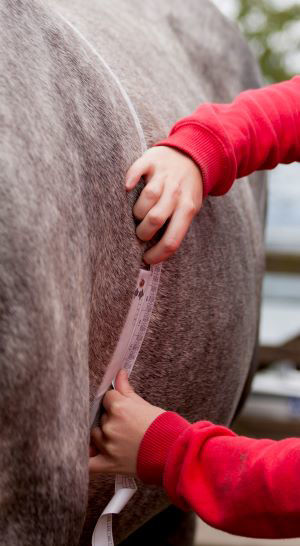
Figure 1. Regularly assessing your horse’s weight and fat stores is important for determining if their diet or management requires adjustment, with weigh tapes offering an easy way of estimating body weight
Reviewing the diet as a whole (grass, preserved forage, concentrate feeds and supplements) is important as fat scoring does not account for intake of other nutrients, although it does provide an indication of the potential nutritional quality of your grass. Ideally you want to utilise the grass as a nutrient source and minimise the amount of concentrate feed you are providing as this will help to maintain gastrointestinal and mental health, and is one of the cheapest forms of feed available.
Limiting Grass Intake
Many owners find they need to limit the amount of grass their horse or pony consumes due to them being prone to weight gain or susceptible to metabolic issues such as laminitis or insulin dysregulation. How best to control the amount of grass your horse eats will depend on the facilities available to you and the amount of flexibility you have using those facilities. The main methods of limiting grass intake are:
- Reducing the amount of time with access to grass
- Overnight grazing
- Reducing the amount of grass your horse has access to (through increased stocking density, or strip grazing)
- Reducing your horse’s ability to consume the grass (such as using grazing muzzle)
1) Reduce the amount of time with access to grass:
Reducing the amount of time your horse has access to grass requires them to spend more time in an alternative environment. For many owners the only other place they can keep their horses is in the stable. Ideally, we want to reduce the stabling period as it reduces their physical movement and time they can interact with other horses, increases their exposure to stable dust which can negatively impact respiratory health and increases bedding and forage costs. There are times when horses have to be stabled rather than out in the field, e.g. due to ill-health, injury, or to reduce exposure to biting midges and flies that irritate the skin, but we would ideally not stable them for extended periods of time to just reduce grass intake. An alternative is to provide access to a dry lot, or fenced area with an alternative ground surface. Such setups prevent grazing whilst allowing movement, social interaction, and fresh air. If using such a setup, access to water and shelter are still required and it is recommended to provide a form of low energy preserved forage so horses can continue trickle feeding but without consuming too many calories.
Reducing time in the field may not always lead to reduced grass intake. The amount of grass consumed, measured as dry matter intake (DMI), is a result of bite rate (number of bites per minute) and bite size (amount of grass per bite), with these factors being influenced by animal size and the amount of grass available. Equids respond to variations in grass availability by increasing or decreasing these bite parameters, with a balance being required to maintain DMI. When ample grass is available larger bites can be taken, however these require more chewing and can result in a lower bite rate, whereas when grass availability is limited, smaller, more frequent bites can be taken. As bite rate increases, selectivity decreases, meaning that when food resources are limited equids have a feeding strategy of maintaining DM and energy intake, rather than selecting for higher nutrient plants. This feeding strategy leads to variations in individual nutrient intakes and their balance within the diet.
When limiting grazing time studies have shown that horses, ponies, and donkeys increase bite rate and/or bite size, leading to a faster DMI. Studies that have restricted ponies to 3-hours grazing per day over a 6-week period and found that the amounts of grass consumed increased over the six weeks, with ponies consuming almost double the amount they consumed at the start of the study. These results indicate that the ponies became accustomed to the management routine and short grazing time, increasing their intake rate to maximise the amount of grass they could eat. Similar results were reported when restricting mature horses to either 3-, 6-, 9- or 24-hours grazing. These researchers found that intake rate increased with decreasing grazing time, being fastest when horses had three hours grazing time and slowest when they had 24-hour access to grass. This faster DMI allows equids to compensate for shorter grazing periods, potentially neutralising any effect of reduced grazing time, although this is dependent on the amount of grass available.
Studies have shown that the amount of grass available prevented horses compensating for the shorter grazing times, leading to significantly less grass being eaten when restricted to six hours grazing or less, compared to when allowed 24 hours access. In a study using donkeys where grass availability was extremely limited, donkeys restricted to 8-, 12- and 23-hours grazing access ate similar amounts of grass as there was no benefit to donkeys grazing for longer due to such sparse pasture. When grass availability increased the donkeys with 23-hours access were at an advantage, able to consume more than those with 12- or 8-hours grazing.
Such results do not mean that restricting time in the field is unsuitable for limiting grass intake, but they do show that the effect of grazing time on your horse’s intake may not be easy to predict and will be affected by the amount of grass available and your individual horse’s response. When the amount of grass available is limited, bite size and bite rate can only increase by so much, meaning that in these circumstances they cannot compensate for reduced time at grass, leading to a lower DMI from grass whilst allowing all the benefits of time in the field previously discussed.
2) Overnight grazing:
Another option available to owners is to allow access to pasture overnight and to stable or keep horses on dry lots during the day. Equids graze less intensively overnight so only turning out overnight may help to reduce intake and is more suitable for some animals affected by biting insects or sunburn. The amount of grass available should still be considered in these circumstances as some equids will adapt to a night grazing routine and simply eat an equivalent amount as they would during the day.
3) Reduce the amount of grass your horse has access to:
An alternative to restricting the amount of time your horse has access to grass is to influence the amount of grass. Shorter grass tends to have lower herbage mass (g DM/hectare) than taller grass, however taller grass is more fibrous and of lower nutritional value, meaning there is no simple answer to what length grass is optimum for horses.
The height of grass has been shown to influence bite parameters, and therefore grass intake, by horses, ponies and donkeys. When grazing shorter grass, smaller, more frequent bites that require less chewing are utilised, allowing equivalent amounts to be consumed as when grazing taller grass. Increased time spent grazing combined with increased bite rate can compensate for shorter grass, meaning that limiting one, or both, of these compensatory options (grazing time or grass height) has the potential for reducing grass intake. Research has found that limiting ponies to very short grass (1-2cm) did effectively limit the amount of grass they could consume, however, having such short grass may damage the pasture and underlying soil structure.
4) Increased stocking density
Increasing the number of animals on the grass is another option for decreasing herbage mass per animal (g DM/animal), although there are a number of factors to consider before choosing this option. With an increased number of equids in a field there will be increased competition for food, water and shelter resources. The increased competition for food is positive if wanting to reduce grass intake, however increased competition for water and shelter will increase animal interactions and potentially the risk of injury.
You also need to ensure that there are no harmful plants, such as ragwort or bracken, that could be consumed if horses become hungry and seek alternative food sources. The effect on pasture quality should also be considered, as over-grazing can cause weeds to proliferate and takeover. Increased weeds are also seen in areas where horses defecate, leading to a greater proportion of the field being left ungrazed due to weeds and toilet areas, which also reduce pasture quality.
A final consideration is the increased potential for parasite transmission between animals. Reducing parasite burdens require the life cycle of the parasite to be broken. This is achieved by identifying infected animals and providing effective treatment, and by removing faeces from the pasture, which can be difficult when large numbers of equids are in the same field.
Grazing with non-equine species such as sheep, overcomes some of these issues whilst reducing herbage mass per animal. Sheep and horses tend to graze different parts of the field, resulting in a more uniform pasture. Sheep and horses are also less likely to cause injury to each other, however fencing required to keep sheep in the field is usually not safe for horses due to the risk of their legs becoming caught. Grazing with sheep also increases the risk of liver fluke in equines therefore it is important to assess and manage this risk.
5) Strip grazing
Controlling the amount of fresh, ungrazed pasture your horse accesses daily using strip grazing is a practical option for many owners, being relatively quick, simple and cheap to setup using electric fencing.
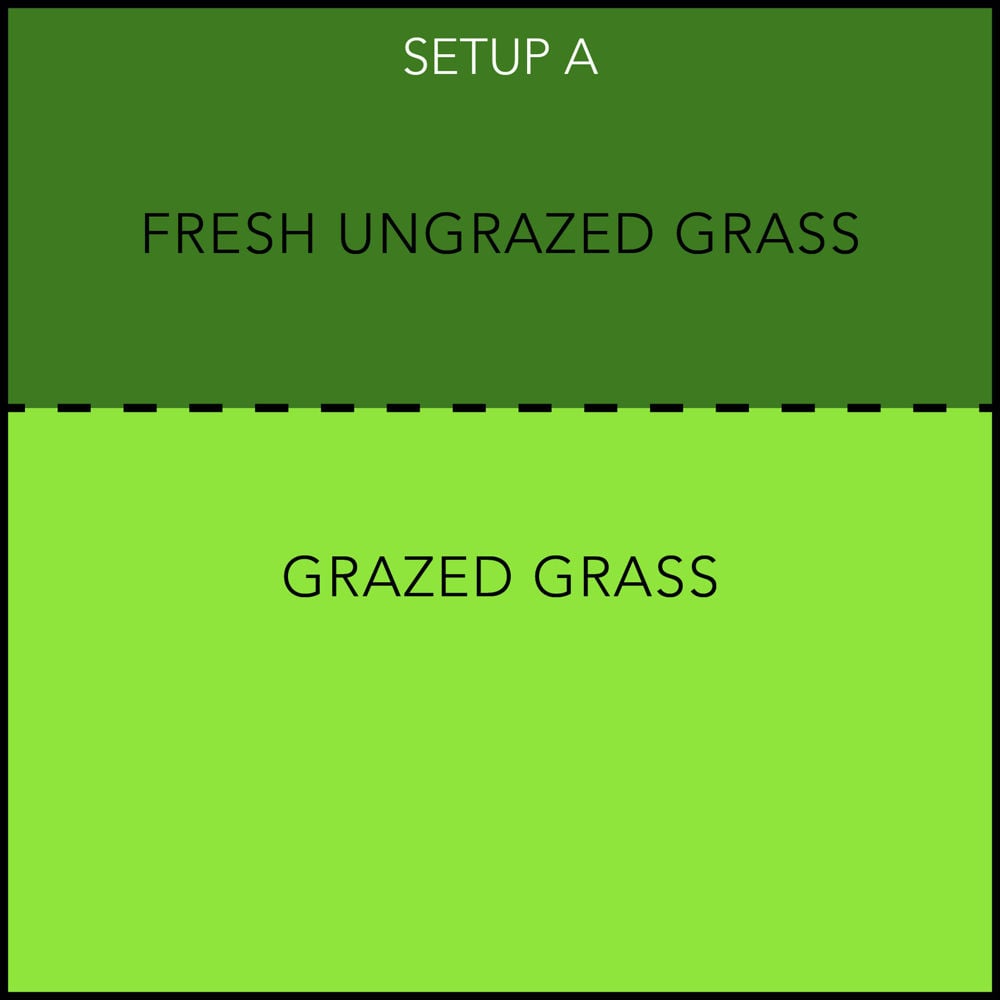
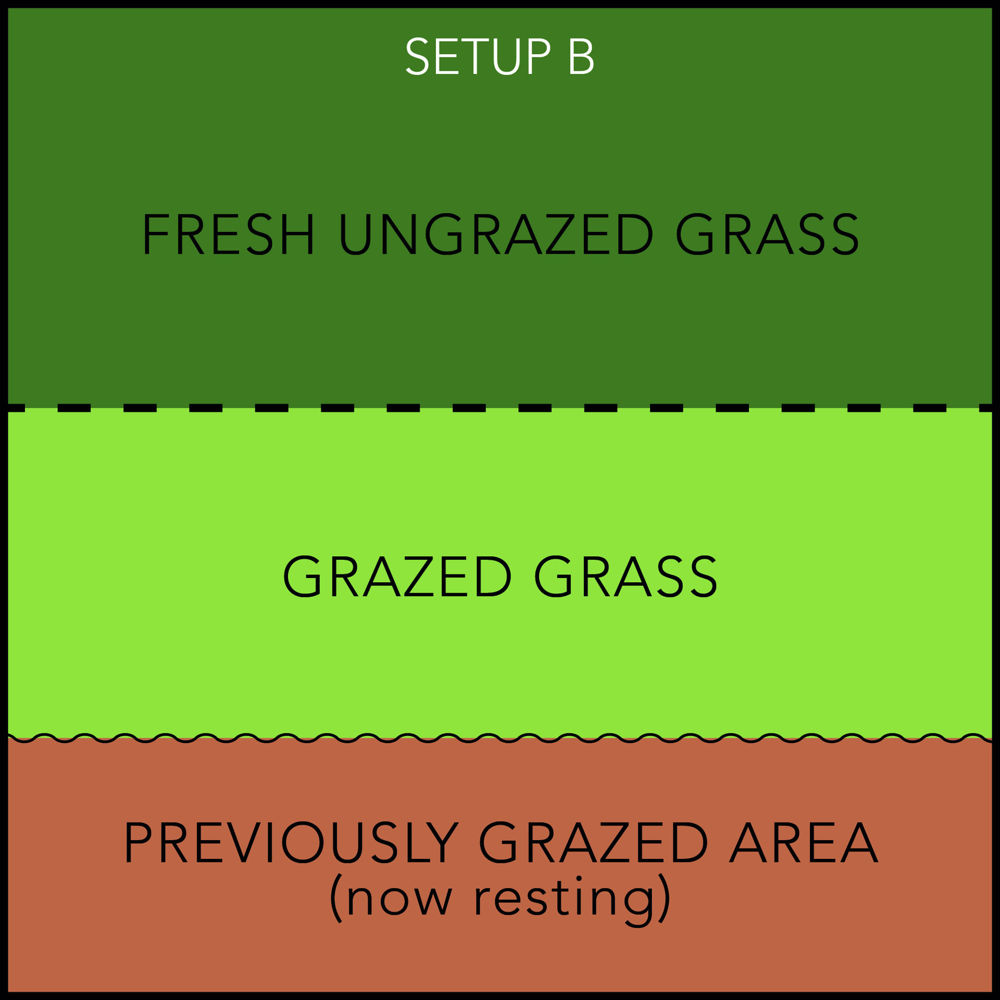
Figure 2. Options for strip grazing equids. Setup A uses a single, lead fence. Setup B uses a lead fence and a back fence to maintain the same size grazing area.
Strip grazing using a single moving fence (Figure 2, Setup A) limits the amount of ungrazed grass your horse can eat, however the total grazing area increases in size over time. As animals preferentially graze the fresh grass, the grass in the remainder of the field has opportunity to grow. This can lead to the beneficial effects of strip grazing being reduced as the overall herbage mass per animal increases. Strip grazing using two fences (Figure 2, Setup B) has a lead fence that moves to allow access to fresh, ungrazed grass, and a back fence that is moved the same distance as the lead fence, that keeps the grazing area size the same. Using two fences not only helps to control herbage mass per animal, but also enables areas of the field to be rested without having to remove animals from the area completely.
Over a 28-day period, researchers looked at the effect of strip grazing on grass intake by ponies with 23-hours access to grass. The study compared the effect of strip grazing using a single lead fence (setup A), strip grazing using a lead and a back fence (setup B), and no strip grazing where ponies had access to a grazing area of equivalent size and herbage mass. Ponies consumed significantly less grass when managed using the strip grazing systems compared to those with no strip grazing, despite the same overall grazing area. The lowest intakes were recorded for ponies managed with a lead and back fence due to them having a smaller grazing area and lower herbage mass per animal. In the first two weeks of the study the ponies in the strip grazing groups grazed all parts of the fresh grass, leaving very little ungrazed grass. This indicated they were not selectively grazing and were focusing on consuming whatever fresh grass they could access. This was opposite to the ponies with access to the whole pasture area who selectively grazed, most likely at a slower rate.
A concern by some owners is that horses, ponies, and donkeys managed using strip grazing, excessively gorge on the fresh grass once access is provided. Such a concern is valid as sudden intakes of fresh, lush grass can lead to gastrointestinal upset. Research that limited adult horses to 8-hours grazing per day and monitored grass DMI over this period, found that the rate of grass intake was greatest (almost double) in the first four hours of grazing than in the second four hours of grazing. If utilising strip grazing, it is worth considering when to allow access to the fresh pasture. If practical, offering fresh grass after animals have already been grazing for several hours, or overnight if managed with 24-hour grazing, may help to reduce this sudden rapid intake. What is very positive is that both methods of strip grazing lead to ponies maintaining a relatively stable body weight over the study period compared to ponies with access to the whole grazing area who gained weight and increased fat stores. Such results show that strip grazing is a useful option for limiting grass intake whilst allowing access to the field.
6) Reduce your horse’s ability to consume the grass:
Reducing your horse’s ability to consume grass can be achieved by using grazing muzzles (Figure 3). Various muzzle designs are available, all aiming to reduce your horse’s bite size, although many equids also seem less motivated to graze when they are wearing a grazing muzzle, suggesting that the effort required to eat may not be worth the small amount of grass gained. The effectiveness of grazing muzzles on reducing grass intake ranged from 83% in ponies grazing over a 3-hour period to 30% in horses grazing over a 4-hour period.
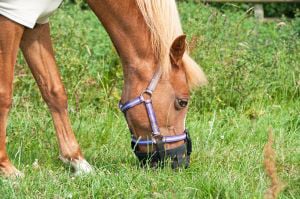
Figure 3. Muzzles are one option for limiting the amount of grass horses can consume whilst allowing them time in the field
The differences between these figures reflects the differences in methods used to estimate intakes and differences in grass height. In one study the ponies were grazing grass 8-15cm tall, whereas in another study the grass was 15-20cm tall. It is thought that grass that is too short cannot reach through grazing muzzles, leaving animals frustrated and likely to dig up short pastures in an attempt to eat something. In contrast, grass that is too long can be difficult to sever and chew when wearing muzzles, potentially reducing intake. The form of the grass can also influence the effectiveness of muzzles. Grasses that grow upright easily poke through the muzzle giving the animal something to eat, whereas grasses that have a wider growth pattern are not as easily accessible. Muzzles seem most appropriate for use when grass is 3-20cm tall, although this will vary with grass species and your individual horse, pony or donkey’s response.
All of these factors need considering when deciding whether to use grazing muzzles. They can certainly help to reduce grass intake however they should not be left on all day, and therefore horses may simply compensate for reduced intake due to being muzzled, by eating rapidly when unmuzzled. Such compensatory responses indicate that grazing muzzles are helpful in managing grass intake if used alongside other practices, such as limiting grazing time or strip grazing.
Animals must be acclimatised to wearing muzzles and checks made that they know how to drink otherwise they risk dehydration. Some animals refuse to drink whilst wearing muzzles which is one reason they should not be worn 24-hours a day. As previously mentioned, some equids are reluctant to even try to graze when wearing a muzzle and spend their time just standing in the field. Whilst this is preferable to standing in a stable, long periods of time without consuming any food are not advised.
Optimising Grass Intake
The phrase ‘Doctor Green’ relates to the nutrients grass can supply to our horses and the beneficial effects of these nutrients. As discussed in Fuel or filler? What is the real nutrient content of grass for horses? grass can be an excellent source of nutrients, and for some horses, it's the food that makes them look and feel at their best. For these animals, the main aim is optimising intake and balancing the diet.
Optimising intake is about correct pasture management. Ensuring there is adequate herbage mass per animal and appropriate grass species for the type of animal, type of soil and weather conditions is important. Discussing your specific requirements with an agronomist with an interest in equine pastures is the best option for achieving a suitable pasture that will have longevity. More immediate actions you can take are to ensure you provide appropriate shelter from inclement weather and the sun. Flies and midges are also deterred from entering dark areas so a shaded area will help to reduce irritation from biting insects. Clean, fresh water with enough access space for multiple horses at once is also essential.
One of the most important actions you can take is to create a clean grazing area by regularly removing faeces from the field. This has multiple benefits, including increasing grazing area per animal, breaking the parasite life cycle, reducing weed development and not attracting flies. It is important that collected faeces are removed from the field and not piled in the field corner as this simply concentrates the issues of flies, parasites, and weeds in one place. By creating a pleasant environment for your animals to graze they are more likely to be settled and enjoy being in the field, taking their time to forage and exhibit their natural grazing behaviour.
Summary
Grass is an extremely useful resource for most equids so long as the amount consumed is managed to match the individual animal’s requirements. For some equids this may mean reducing time in the field and increasing time in a dry lot, arena, or stable, whilst for others a grazing muzzle is the perfect tool for limiting grass intake. For those who seem to blossom when Doctor Green is here then providing clean, hygienic grass should be the focus. When not grazing, providing a suitable preserved forage will enable trickle feeding to continue and optimise gastrointestinal, and mental health.


